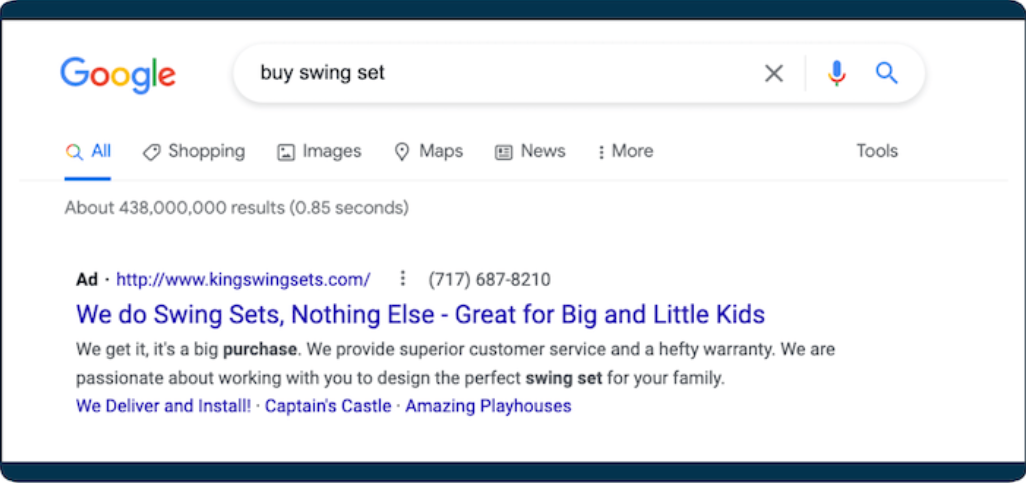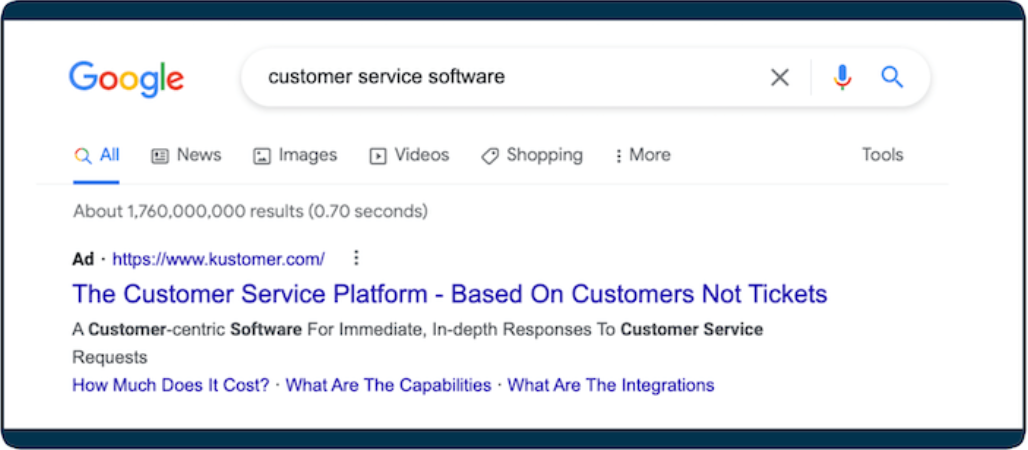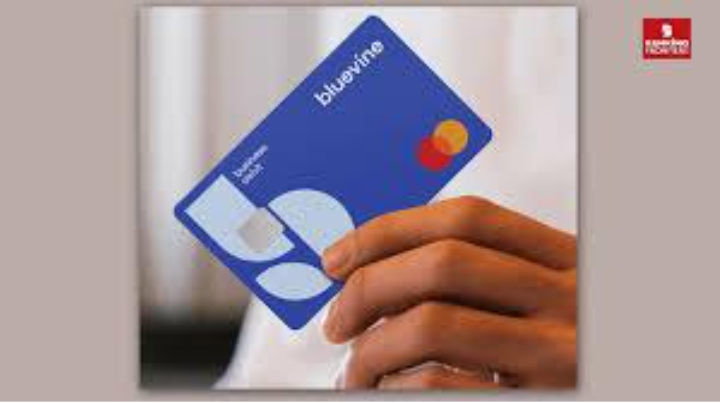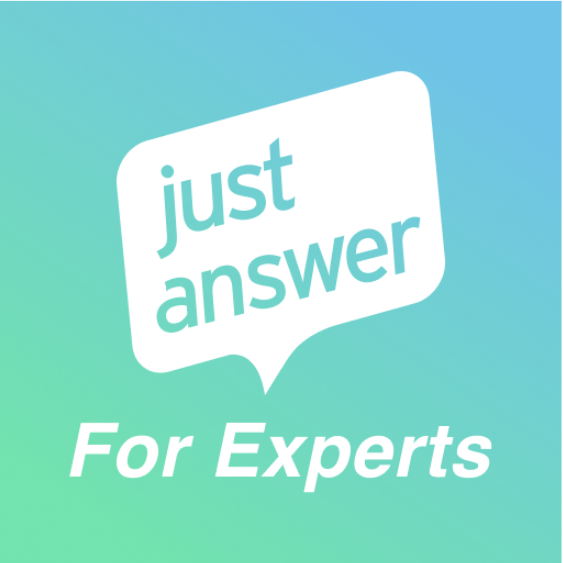
Are you curious about how to write effective Google Ads?
Google Ads is a dynamic platform that can help businesses reach their target audience more directly and efficiently. However, with the intense competition online, creating an ad that stands out and converts can be challenging. To help you craft Google Ads that get noticed and perform well, here are seven detailed examples with tips on how to make the most of your ads, as well as common mistakes in Google Ad Campaigns to avoid.
Let’s understand the intricacies of Google Ads with the best of its examples and analyse it further. Enjoy the master breakdown picked by our Google Ads Agency experts of the most performing case studies and build yourself a ladder to Google Ads success.

1. The Snappy Specialist: “We Do Swing Sets, Nothing Else”
Image Source- Wordstream
King Swing Sets’ Google ad features the headline “We Do Swing Sets, Nothing Else,” making a bold statement about their niche. This focused approach immediately communicates their expertise and specialization, attracting customers looking specifically for swing sets rather than general outdoor equipment.
Tip: Niche down to stand out.
By clearly stating what they specialize in, King Swing Sets sets expectations for potential customers. It’s a straightforward approach that ensures the ad reaches the right audience, people specifically interested in buying a swing set, not generic outdoor gear.
Common Mistake: Over-generalizing.
Many businesses try to cast a wide net, offering a broad range of products or services. While this can increase reach, it often results in a diluted message. Trying to cater to everyone can make your ad seem less focused and relevant, leading to lower engagement and fewer conversions.
Solution: Be specific in your messaging to highlight what you excel at and who your target audience is.
2. The USP: “The Customer Service Platform – Based on Customers Not Tickets”

Kustomer’s ad for its customer service platform stands out with the tagline: “Based on Customers Not Tickets.” This phrase is a clever way to emphasize their unique approach to customer service, which focuses on the individual customer experience rather than simply resolving support tickets.
Tip: Emphasize what makes you unique.
In today’s crowded marketplace, simply listing features or products isn’t enough. Kustomer’s ad differentiates itself by focusing on the underlying philosophy of its service. This not only grabs attention but also creates a memorable impression, encouraging potential customers to click and learn more.
Common Mistake: Focusing only on features.
While it’s important to highlight the features of your product or service, focusing solely on these can make your ad blend in with the competition. Potential customers often care more about how your offering solves their problems or makes their lives easier than about the technical features alone. This Google Ads Mistake can bring all your efforts down.
Solution: Make sure to connect the feature to the benefit—what sets your product apart and why it’s the better choice for your target audience.
3. The Feature Drop: “AI to Deduct User Sentiments”
Zoho’s ad for its customer service software promotes the innovative feature: “AI to Deduct User Sentiments.” This highlights a specific, cutting-edge tool that can analyze customer interactions and gauge their emotions, making it an attractive offering for businesses looking to enhance their customer experience through technology.
Tip: Highlight unique features that solve a specific problem.
People are drawn to new, innovative features that can make their lives easier or their work more efficient. By emphasizing this AI-powered sentiment analysis, Zoho makes it clear that its platform offers something that competitors may not, enticing businesses that are focused on improving customer engagement through technology.
Common Mistake: Failing to explain why the feature matters.
Simply listing features like “AI sentiment analysis” may not mean much to your audience unless you explain how it can benefit them.
Solution: Provide context and explain how this feature addresses a pain point. In Zoho’s case, emphasizing how AI can improve customer satisfaction and retention would make the ad even more compelling.

4. The Benefit Banker: “Focus, Energy, Clarity – Hours of Focus, Zero Crash”
Logo Of TakeThesis
Image Source- LinkedIn
The thesis ad for Take Thesis’s nootropic supplement uses a clear, compelling benefit-driven headline: “Focus, Energy, Clarity – Hours of Focus, Zero Crash.” This ad directly communicates the desired outcome for users—enhanced cognitive function without the dreaded energy crash that often follows other stimulants.
Tip: Focus on the outcome, not just the product.
Benefit-driven ads are more likely to convert because they speak directly to the customer’s needs and desires. The thesis ad focuses on the outcome—maintaining focus and energy—rather than just the product, making it more relatable and appealing to people looking for a solution to their energy and focus challenges.
Common Mistake: Overloading the ad with features.
When ads focus too much on the technical details of a product, it can confuse the customer or fail to appeal to their emotions. Instead of just listing ingredients or product specifications, focus on how the product can make the customer’s life better.
Solution: Connect the features to the benefits your audience cares about.
5. The Qualifier: “Small Business Loans – Requires $100K + Annual Revenue”

BlueVine’s ad for its small business loan product clearly states the eligibility criteria: “Requires $100K + Annual Revenue.” This upfront information ensures that only business owners who meet the requirements are likely to click on the ad, making it more efficient and cost-effective.
Tip: Pre-qualify your audience.
If your product or service has specific eligibility requirements or a target audience, make those clear in the ad. This will help filter out clicks from people who don’t qualify, saving you money on wasted ad spend and ensuring that those who do click are more likely to convert.
Common Mistake: Not pre-qualifying your audience.
Without qualifying language, your ad might attract clicks from people who are not eligible for your service or product. This can result in poor ad performance, increased bounce rates, and wasted advertising spending.
Solution: Include clear qualifications or criteria in your ad to filter out non-relevant audiences.
6. The Speed Demon: “Ask a Lawyer: Fraud – Lawyer Will Answer in Minutes”

JustAnswer’s ad focuses on speed with the headline: “Lawyer Will Answer in Minutes.” This creates a sense of urgency and assures potential customers that they’ll get immediate answers to their legal questions, which is often a top priority when people are seeking legal advice.
Tip: Highlight speed when it’s important to your customers.
If your service is time-sensitive, make sure your ad emphasizes how quickly customers can expect results. For industries where immediacy matters—such as legal advice, customer service, or emergency repairs—speed is a powerful motivator for customers to take action.
Common Mistake: Not emphasizing urgency when needed.
Ignoring the need for speed in your messaging could mean missed opportunities, especially if your customers are expecting fast responses.
Solution: If speed is a key part of your offering, make sure to highlight it clearly in your ad.
Key Takeaways for Your Google Ads Success:
- Niche down to stand out – Specialize to reach your target audience more effectively.
- Differentiate yourself – Show why your product or service is better than the competition.
- Focus on outcomes – Connect features to the benefits your audience cares about.
- Pre-qualify your audience – Ensure you’re attracting the right people to your ad.
- Be conversational – A friendly tone makes your brand feel more relatable.
- Highlight speed when relevant – Create urgency in time-sensitive industries.
By following these tips and avoiding common mistakes, you’ll be able to create Google Ads that don’t just grab attention but also drive real, measurable results. With the right messaging, you can optimize your ad spend and boost conversions.
Conclusion: Crafting Google Ads that Convert
Creating compelling campaigns by following Google Ads best practices is both an art and a science. By using specific, benefit-driven language, emphasizing what makes your product or service unique, and speaking directly to your target audience’s needs, you can craft ads that not only stand out but also drive action. Avoiding common mistakes such as over-generalizing your message or neglecting the urgency factor will help you fine-tune your ads for maximum effectiveness.
Remember, Google Ads are an investment in your business’s growth. By learning from the examples shared, using the right strategies, and continuously optimizing your approach, you can ensure that your ads not only get clicked but also convert into loyal customers. Test and refine your ads over time to stay ahead of the competition and ensure your marketing dollars are working as efficiently as possible. With these tips in mind, you’ll be well on your way to creating high-performing Google Ads that deliver results.
With Satnam Webtech’s affordable Google Ads Pricing and top-notch servings, you can hand over the process to us and enjoy the up-to-mark results that your business deserves.